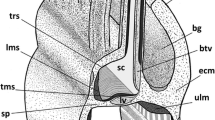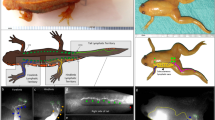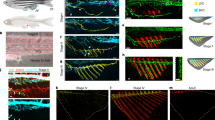Abstract
Lymphatic capillaries are distributed throughout the body of lepidosirenid and protopterid Dipnoi, except in the central nervous system. They form small, interconnected units which are individually evacuated into nearby blood capillaries by lymphatic micropumps. The number of lymphatic micropumps varies considerably in different parts of the body. In fin areas, 30–50 per mm3 tissue may be considered normal in Protopterus annectens, but up to 105 per mm3 have been counted in an anterior fin of Lepidosiren paradoxa. Lymphatic capillaries are formed by thin endothelial cells with fine processes into the surrounding interstitial space. Occasionally there is a faint, discontinuous basal lamina. Pericytes, however, are completely absent. Microfibrils establish contact between endothelial cells and surrounding connective tissue fibers. The lymphatic micropumps are essentially spherical, contractile organs of 35–55 μm in diameter. Their central lumen is lined by extensions of a single endothelial cell. Additional endothelial cells form inflow and outflow valves. The endothelial layer is surrounded by a single large, highly specialized muscle cell. This spherical muscle cell has many perforations, allowing the passage of thin outward processes of the endothelial cell which form part of the suspension apparatus of the lymphatic micropump. The muscle cell establishes a specialized end-to-end contact between opposing parts of its own cell membrane. This contact is very similar to an intercalated disc in vertebrate heart muscle. Each lymphatic micropump is suspended within a cell-free tissue area by microfibrils which radiate from the lymphatic micropump into the surrounding connective tissue. The microfibrils are occasionally reinforced by single collagen fibers. The cell-free area around each lymphatic micropump appears as a bright halo in both light and electron micrographs. No type of lymphatic vessel other than lymphatic capillaries could be detected in the Dipnoi studied. Lepidosireniform Dipnoi are the only Vertebrata besides the Tetrapoda in which lymphatic vessels and characteristic lymphatic pumps have been documented. In addition, these Dipnoi and all Tetrapoda share the same overall design of blood circulation, which is not divided into a primary and a secondary system of vessels, as it is in Actinopterygii, Chondrichthyes, and Agnatha. Since there are primary and secondary blood vessels in the gills of Latimeria chalumnae, while the existence of lymphatic vessels has not been confirmed, general angioarchitecture should be taken into account as an important character when phylogenetic relationships among extant Sarcopterygii are discussed.
Similar content being viewed by others
Author information
Authors and Affiliations
Additional information
Accepted: 7 October 1997
Rights and permissions
About this article
Cite this article
Vogel, W., Mattheus, U. Lymphatic vessels in lungfishes (Dipnoi) . Zoomorphology 117, 199–212 (1998). https://doi.org/10.1007/s004350050045
Issue Date:
DOI: https://doi.org/10.1007/s004350050045




